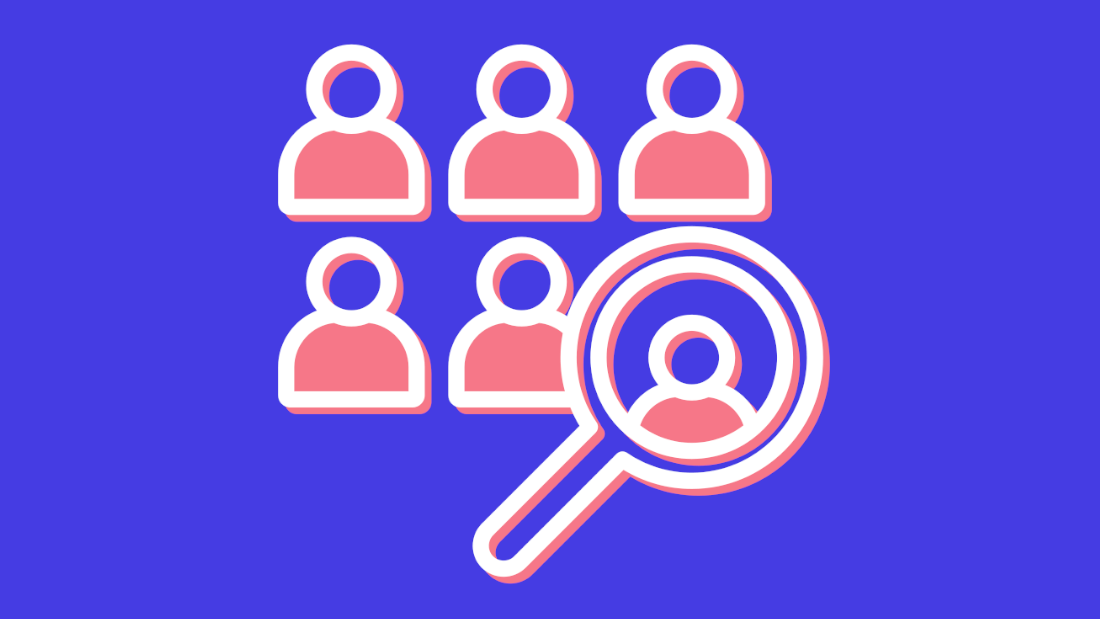Recruiting the right participants for research is the most difficult part of the process – and will also determine whether you fail, or succeed.
The other day, I went for a coffee with one of my colleagues, a very talented product designer, who had been given the job of conducting a usability testing research study.
We talked about how difficult user research can be, especially in organisations which aren’t 100% convinced of its value, and don’t recognise research as a specialist skill.
We also agreed that identifying and recruiting the specific people who can provide the insight you need is the biggest challenge of all.
In this post, I’ll outline some advice and best practice based on my experience over the years. I hope you’ll find it useful.
1. Define your research goals
When addressing any research challenge, the first thing you should do is define:
- the purpose of the research
- the reasons for doing it
It is vital to clarify with your stakeholders the ultimate outcome they are trying to achieve.
What is the challenge? What are we trying to uncover? What are the current barriers and pain points faced by users? What do users need?
These are just some of the questions you need to ask yourself and your team.
Having this information will support your understanding of the challenge and allow you to design a research plan that tackles the right issue.
Co-designing a user journey alongside your client is a helpful exercise to understand the paths users typically take, including the main bottlenecks and barriers.
This will inform your understanding and help you create a robust research brief.
I’ve noticed that for consultants there is some stigma around admitting to your clients that you have gaps in your knowledge – but there is absolutely nothing wrong with doing that. In fact, the more experienced you become, the more comfortable you get asking ‘stupid’ questions.
Remember, while you are the design expert, they are the experts in their fields.
Your job is to use design to improve their products and services, not to know it all. So, feel free to start any research project with a blank canvas.
If doing this exercise is not an option, I suggest you conduct desktop research, or lean on any research previously done. This will give you at least some focus before diving into the work.
The key thing here is to feel informed about what you are trying to resolve before moving onto the next step.
2. Define who you need to recruit for your research
Once we are clear on the ‘what’ we move onto the ‘who’.
Having a clear definition of who our users are, and clear recruitment criteria, is how we ensure we talk to the right people, in the right order.
Because we usually end up doing research with multiple user groups it is important to understand:
- where they step into the service journey
- their motivations for using the service or product you’re researching
This will help you prioritise these user groups and decide on the research methodology.
In a recent project I worked on in the public sector, after having done the due diligence research of who our users were, we identified five user groups.
One of them was ultimately the end user and probably the one most people would have started the research with.
However, I decided to start with the user group working backstage instead – a decision that shocked even my own team.
My thinking was that by taking this approach, I was going to learn about the challenges end users were facing from those with first-hand experience of supporting them, which would feed directly into my research brief.
I’m relieved and happy to confirm that my possibly risky approach was a success!
Once you’ve defined user groups, you’ll also need to segment each group by, for example:
- demographics – age, education, income
- behaviours and approach – what they do and how they do it
- geography – are they based in the city or countryside?
- level of expertise using the service or product
- overall experience in the industry you are researching
In one piece of work I was involved in we decided to split the research into two separate workstreams. One was focused on testing the features and intuitiveness of the prototype itself, while the other was focused on testing the strategic approach we took in building the service.
To ensure we gathered the right input, we based our decision-making on users’ exposure to the service as well as their level of confidence and awareness around the service itself.
This approach allowed us to conduct research with nearly 20 participants in less than a week, covering both the usability and the strategic aspect of the service we were designing.
3. Getting access to users
Next, we need to determine how many users we want to talk to and how we are going to get access to them.
The number of participants will depend on the research methodology you are going to apply.
For most qualitative research, 5 participants for each user group is an acceptable number – although the right time to stop doing research is when you have reached saturation point. In other words, when carrying out more research won’t change the themes and insights you’ve already identified.
Getting access to the right users will depend on the industry you are researching, and the type of product or service you are designing.
If you are working in retail or the healthcare industry, for example, it will be easier to get hold of users. After all, we’ve all been patients or bought something at least once in our lives.
But what if you are doing research for a more niche product? I like to use what I call the pyramid approach.
I start by leaning on our client’s network to gain access to users. As experts in their respective fields, they bring the reputation and recognition needed to get to users, and to do so fast.
I once conducted research for a client using lean start-up techniques to deliver a service following a UK Government Digital Service (GDS) approach. That meant we had to go through the full GDS cycle of discovery, alpha, beta and live within 10 weeks.
I managed to get hold of 30+ users by drawing on the client’s networks and contacts. So, never be afraid to ask for support from your client.
However, if this approach doesn’t work, I then move onto reaching out to our extended network, using online forums and social media channels, or recruitment agencies.
For accessibility research, I would always go straight to a recruitment agency and use an incentivisation approach. Otherwise, it can be really difficult to reach the right participants.
4. Keeping users engaged
Finally, I would like to emphasise on the importance of keeping users engaged. This will not only guarantee you always have a user pool you can rely on but also ensure your service is always built with the user at the core.
My top tips to keep users engaged are:
Take a user-centred approach
Put yourself in the shoes of users and focus on their needs and motivations. Ensure they feel involved in the process by speaking from their perspective and using their language. This human and personable approach helps maintain engagement throughout the research.
Share your work
Continuously share iterated versions of the service with participants to keep them involved. This approach is especially powerful in a GDS framework and demonstrates the impact of their feedback on public services, fostering a sense of inclusion and ownership.
Use incentives
I don’t want to romanticise research. In some cases, a user-centred approach may not be enough to keep participants engaged. In such scenarios, use incentives like vouchers or gift cards. Avoid handling cash, though, and ensure this approach matches with your client’s policies.
Participant recruitment in a nutshell
To recap, conducting user research is a challenging task that requires real expertise.
Identifying and recruiting the right participants is crucial for research success.
Clear research goals, user journeys, and recruitment strategy can help.
Use client networks to gain access to the right users but, if that doesn’t work, use recruitment agencies and incentives.
Following this best practice will set you up for success and ensure you gain effective insights and design better products and services in any research challenge you undertake.



